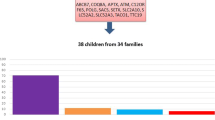Abstract
ARV1 mutation is known to present as developmental and epileptic encephalopathy (DEE)-38. However, the phenotypic spectrum has been expanding ever since it was reported in 2016. Along with seizures and developmental delay, other unique clinical features include ophthalmological abnormalities and movement disorders in the form of ataxia and dystonia, especially in those with missense mutation. These manifestations closely mimic ataxia telangiectasia. Elevation of alpha-fetoprotein levels is an important investigative marker in the diagnosis of ataxia telangiectasia and ataxia with oculomotor apraxia syndromes. ARV1 can also be associated with increased alpha-fetoprotein. There are no reports evaluating alpha-fetoprotein levels in cases with ARV1 mutation, which is significant in the context of ocular abnormalities with ataxia. We report a case of ARV1 mutation presenting with ataxia, ocular abnormalities, and elevated alpha-fetoprotein levels, thus mimicking autosomal recessive cerebellar ataxias. This study provides a comprehensive literature review of the cases reported so far, thus expanding the understanding of the spectrum of presentation, and helps in correlating the clinical picture with the underlying causative genetic mutation. ARV1 gene is another example of one gene with phenotypic pleiotropy. Though presentation with DEE is common, a few, especially those with missense mutations, can present with ataxia and ocular abnormalities. All cases presenting with ataxia who have increased alpha-fetoprotein levels and seizures should be tested for the ARV1 gene, when testing for ataxia genes is negative. The underlying genetic mechanism can explain the varying clinical manifestations of the ARV1 gene.

Similar content being viewed by others
Data Availability
Not applicable.
References
Scala M, Bianchi A, Bisulli F, Coppola A, Elia M, Trivisano M, et al. Advances in genetic testing and optimization of clinical management in children and adults with epilepsy. Expert Rev Neurother. 2020;20(3):251–69. https://doi.org/10.1080/14737175.2020.1713101.
Alazami AM, Patel N, Shamseldin HE, Anazi S, Al-Dosari MS, Alzahrani F, et al. Accelerating novel candidate gene discovery in neurogenetic disorders via whole exome sequencing of prescreened multiplex consanguineous families. Cell Rep. 2015;10:148–61. https://doi.org/10.1016/j.celrep.2014.12.015.
Palmer EE, Jarrett KE, Sachdev RK, al Zahrani F, Hashem MO, Ibrahim N, et al. Neuronal deficiency of ARV1 causes an autosomal recessive epileptic encephalopathy. Hum Mol Genet. 2016;25:3042–54. https://doi.org/10.1093/hmg/ddw157.
Paucar M, Taylor AMR, Hadjivassiliou M, Fogel BL, Svenningsson P. Progressive ataxia with elevated alpha-fetoprotein: diagnostic issues and review of the literature. Tremor Other Hyperkinet Mov (N Y). 2019;10:9. https://doi.org/10.7916/tohm.v0.708.
Nashabat M, Al Qahtani XS, Almakdob S, Altwaijri W, Ba-Armah DM, Hundallah K, Hashem AA, et al. The landscape of early infantile epileptic encephalopathy in a consanguineous population. Seizure. 2019;69:154–72.
Davids M, Menezes M, Guo Y, McLean SD, Hakonarson H, Collins F, et al. Homozygous splice-variants in human ARV1 cause GPI-anchor synthesis deficiency. Mol Genet Metab. 2020;130:49–57. https://doi.org/10.1016/j.ymgme.2020.02.005.
Renaud M, Tranchant C, Koenig M, Anheim M. Autosomal recessive cerebellar ataxias with elevated alpha-fetoprotein: uncommon diseases, common biomarker. Movement Disord. 2020:35. https://doi.org/10.1002/mds.28307.
Darra F, Lo Barco T, Opri R, Parrini E, Bianchini C, Fiorini E, et al. Migrating focal seizures and myoclonic status in ARV1-related encephalopathy. Neurol Genet. 2021;7:e593. https://doi.org/10.1212/NXG.0000000000000593.
Salian S, Scala M, Nguyen TTM, Severino M, Accogli A, Amadori E, et al. Epileptic encephalopathy caused by ARV1 deficiency: refinement of the genotype–phenotype spectrum and functional impact on GPI-anchored proteins. Clin Gen. 2021:1–8. https://doi.org/10.1111/cge.14033.
Alam CAL, Rida F, Farhat R, Ladeveze V. Correlation between ARV1 mutation and early infantile epileptic encephalopathy: a second case worldwide. Acta Sci Clin Case Rep. 2021;2(2):13–8.
Segel R, Aran A, Gulsuner S, Nakamura H, Rosen T, Walsh T, et al. A defect in GPI synthesis as a suggested mechanism for the role of ARV1 in intellectual disability and seizures. Neurogenetics. 2020;21:259–67.
Karabinos A, Hyblova M, Eckertova M, Tomkova E, Schwartzova D, Luckanicova N, et al. Dilated cardiomyopathy is a part of the ARV1-associated phenotype: a case report. J Med Case Reports. 2022;16:98. https://doi.org/10.1186/s13256-022-03291-0.
Amadori E, Scala M, Cereda GS, Vari MS, Marchese F, Di Pisa V, et al. Targeted re-sequencing for early diagnosis of genetic causes of childhood epilepsy: the Italian experience from the ‘beyond epilepsy’ project. Ital J Pediatr. 2020;46(1):92. https://doi.org/10.1186/s13052-020-00860-1.
Esmaeilzadeh E, Bayat S, Mirfakhraie R, Gholami M. Whole exome sequencing identified a novel homozygous ARV1 mutation in an Iranian family with developmental and epileptic encephalopathy-38. Meta Gene. 2021:100953. https://doi.org/10.1016/j.mgene.2021.100953.
Author information
Authors and Affiliations
Contributions
Mahesh Kamate diagnosed and was involved in the management of the patient. He will act as guarantor of the study. Thanuja Basavanagowda collected the data and drafted the paper. The final manuscript was approved by all the authors.
Corresponding author
Ethics declarations
Ethics Approval
Ethics approval was obtained from Institutional Ethics Committee.
Consent to Participate
Written informed consent was obtained from parents for publishing the details of their child.
Competing Interests
The authors declare no competing interests.
Additional information
Publisher’s Note
Springer Nature remains neutral with regard to jurisdictional claims in published maps and institutional affiliations.
Supplementary Information
ESM 1
(PNG 3140 kb)
Rights and permissions
Springer Nature or its licensor (e.g. a society or other partner) holds exclusive rights to this article under a publishing agreement with the author(s) or other rightsholder(s); author self-archiving of the accepted manuscript version of this article is solely governed by the terms of such publishing agreement and applicable law.
About this article
Cite this article
Kamate, M., Basavanagowda, T. ARV1 Gene: A Novel Cause of Autosomal Recessive Cerebellar Ataxia with Elevated Alpha Fetoprotein. Cerebellum (2023). https://doi.org/10.1007/s12311-023-01606-5
Accepted:
Published:
DOI: https://doi.org/10.1007/s12311-023-01606-5




